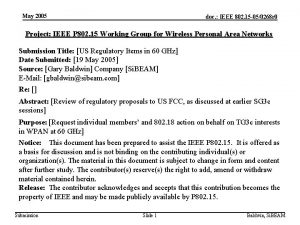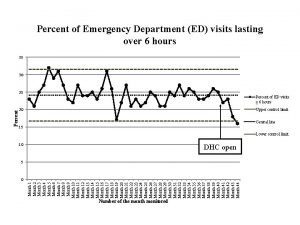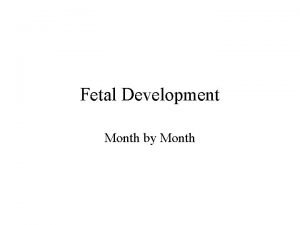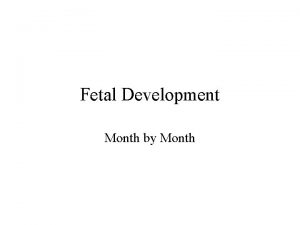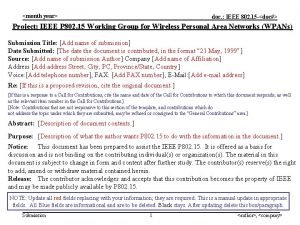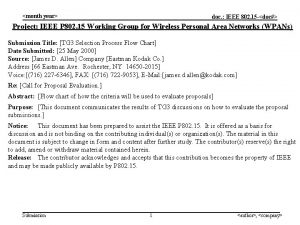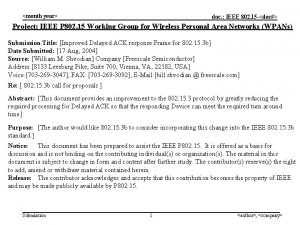doc IEEE 802 11 050268 r 0 Month









- Slides: 9

doc. : IEEE 802. 11 -05/0268 r 0 Month Year Need for Site Specific / Location Specific RF Management Date: 2005 -07 -19 Author: Name Company Address Phone veera@wirelessvalley. com Veera Anantha Roger Skidmore email Wireless Valley 2404 Rutland Drive, Austin, TX 78738 512 -821 -1560 roger@wirelessvalley. com Notice: This document has been prepared to assist IEEE 802. 11. It is offered as a basis for discussion and is not binding on the contributing individual(s) or organization(s). The material in this document is subject to change in form and content after further study. The contributor(s) reserve(s) the right to add, amend or withdraw material contained herein. Release: The contributor grants a free, irrevocable license to the IEEE to incorporate material contained in this contribution, and any modifications thereof, in the creation of an IEEE Standards publication; to copyright in the IEEE’s name any IEEE Standards publication even though it may include portions of this contribution; and at the IEEE’s sole discretion to permit others to reproduce in whole or in part the resulting IEEE Standards publication. The contributor also acknowledges and accepts that this contribution may be made public by IEEE 802. 11. Patent Policy and Procedures: The contributor is familiar with the IEEE 802 Patent Policy and Procedures <http: // ieee 802. org/guides/bylaws/sb-bylaws. pdf>, including the statement "IEEE standards may include the known use of patent(s), including patent applications, provided the IEEE receives assurance from the patent holder or applicant with respect to patents essential for compliance with both mandatory and optional portions of the standard. " Early disclosure to the Working Group of patent information that might be relevant to the standard is essential to reduce the possibility for delays in the development process and increase the likelihood that the draft publication will be approved for publication. Please notify the Chair <stuart. kerry@philips. com> as early as possible, in written or electronic form, if patented technology (or technology under patent application) might be incorporated into a draft standard being developed within the IEEE 802. 11 Working Group. If you have questions, contact the IEEE Patent Committee Administrator at <patcom@ieee. org>. Submission 1 Veera Anantha, Wireless Valley

doc. : IEEE 802. 11 -05/0268 r 0 Month Year. July 2005 Introduction • Motivation for using “site-specific” or “location specific” RF design and RF management – What does this mean • Example usage scenarios • Does this translate to any additional requirements for TGv ? Submission 2 Veera Anantha, Wireless Valley

doc. : IEEE 802. 11 -05/0268 r 0 Month Year. July 2005 Designing and Managing Wireless Networks – Site-specific Environment • Site-specific environment represents the physical environment such as walls / obstructions in relation to – APs or transmitters location and 3 D characteristics (including mesh topologies) – Clients / users location – Usage requirements • Indoor and outdoor physical environments – Taking into account the most significant obstructions such as walls or obstructions within a building, and buildings and significant “clutter” outdoor gives significant improvement in the ability to design, deploy and manage a wireless network • Clients and usage requirements – Taking into account the user densities, logical networks, mesh topologies, service quality in the desired service areas can ensure that the desired service quality can be provided to the user • Site-specific knowledge in conjunction with measured statistics is important to consider in the design and management of a wireless network Submission 3 Veera Anantha, Wireless Valley

doc. : IEEE 802. 11 -05/0268 r 0 Month Year. July 2005 Site-specific RF Design and Management • Utilizing site-specific knowledge (environment, APs, clients, usage requirements) that is available a-priori will result in more efficient RF management – Such site-specific knowledge is typically created in many real world midto-large scale WLAN deployments while designing / provisioning the network (hence available a-priori) – This site-specific knowledge is kept “current” by user inputs and measurements from the environment (role for TGv) • Relying only on AP / client measurements to implement RF management is likely to lead to less optimum management Submission 4 Veera Anantha, Wireless Valley

doc. : IEEE 802. 11 -05/0268 r 0 Month Year. July 2005 Some Example Scenarios • Example of maintaining service quality for clients in a general area while minimizing overhead – Provide the service to client located / moving in a room by using the AP (s) that best serves the room overall even though some parts of the room may have even better service from another AP (s) – Achieves desired service quality while minimizing handoffs • Load Balancing example by reconfiguring AP powers to accommodate change in usage requirements – Increase power on one AP to alleviate load from other APs – Achieve efficient load balancing using site-specific knowledge Submission 5 Veera Anantha, Wireless Valley

doc. : IEEE 802. 11 -05/0268 r 0 Month Year. July 2005 Achieving Desired Qo. S and Minimizing Handoffs AP 2: Ch. 1 15 m. W 802. 11 g Client #1: Ch. 6 (AP 1) (conf room) AP 1: Ch. 6 15 m. W 802. 11 g Submission Association Client device is located within a conference room which has good service from AP 2 in a small area, but best overall service from AP 1. With site-specific information, association can be kept steady with AP 1. This avoids unnecessary handoffs and overhead 6 Veera Anantha, Wireless Valley

doc. : IEEE 802. 11 -05/0268 r 0 Month Year. July 2005 Load Balancing By Reconfiguring AP powers AP 2: Ch. 1, 30 m. W 802. 11 g Client 1: High bandwidth client: Ch 1, (AP 2) Client #2: Ch 11 (AP 2 ? ) AP 1: Ch. 6 1 m. W 802. 11 g Association AP 3: Ch. 11, 30 m. W 802. 11 g Client 1 requires high bandwidth and is associated with AP 2. New client (client #1) comes online and is likely to associate with AP 2, . which would cause an unbalanced loading on AP 2. Submission 7 Veera Anantha, Wireless Valley

doc. : IEEE 802. 11 -05/0268 r 0 Month Year. July 2005 Load Balancing By Reconfiguring AP powers AP 2: Ch. 1, 30 m. W 802. 11 g Client 1: High bandwidth client: Ch 6, (AP 2) Client #2: Ch 11 (AP 1) AP 1: Ch. 6 15 m. W, 802. 11 g Association . Submission AP 1 increases its power levels in order to serve the needs of client 1 so that loading on AP 2 can be reduced. 8 Veera Anantha, Wireless Valley

doc. : IEEE 802. 11 -05/0268 r 0 Month Year. July 2005 Conclusion • In many real world deployments, site-specific design and management of the wireless network is important to ensure a successful deployment • Site-specific environment knowledge, in conjunction with measurements from APs and clients are very important to consider in this analysis • What does this mean for TGv (some suggestions) ? – Need a fairly flexible mechanism to allow the RF management system to request clients to associate with specific APs – Power control mechanisms – Should there be a mechanism to push down a subset of the site-specific data to the client ? Submission 9 Veera Anantha, Wireless Valley










